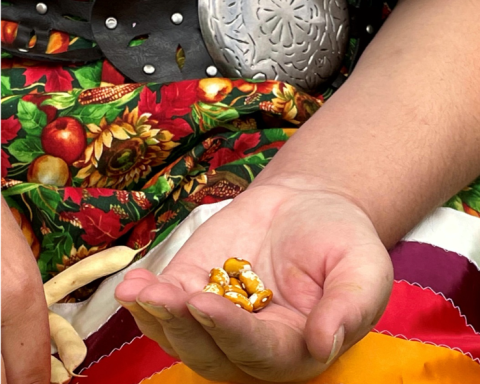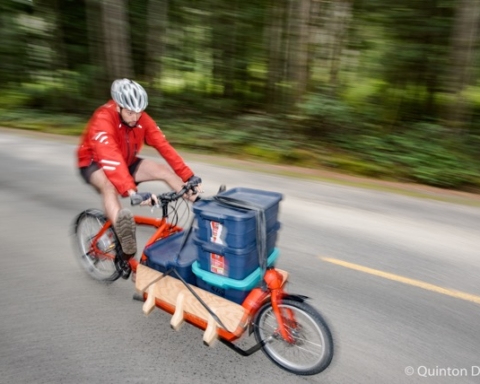Marjorie Harris BSc, IOIA V.O. P.Ag
When I think of the ‘wholeness’ of a bioregional ecosystem and imagine the inner workings to identify which biological organisms could have the greatest influence on the entire system, nothing seems to compete with the influential power of the domesticated honey bee.
This industrious pollinator flies great distances to gather nectar and pollen. The Canadian Organic Standards (COS) Clause 7.1.10 recognizes the prodigious flying capacity of the honey bee by requiring apiaries to be protected by a three kilometre buffer zone from pesticides, GMO crops, sewage sludge, and other environmental contaminants. I decided to calculate just how big of an area a three kilometre radius would cover—an astounding 28.27 square kilometers! Wow! The domesticated honey bee’s influence in a bioregion extends over a huge pollination territory.
RELATED ORGANIC REGULATIONS
CAN/CGSB-32.310 7.1.10 Location of hives
Where sources or zones of prohibited substances are present, that is, genetically engineered crops or environmental contamination, apiaries shall be protected with a buffer zone of 3 km (1.875 mi.).
CAN/CGSB-32.310 7.1.7 When bees are placed in wild areas, impact on the indigenous insect population shall be considered.
In stark contrast to the honey bee’s huge domain is the relatively small realm of influence the humble bumble bee commands. There are well over 450 native bee species in British Columbia and 45 of those are bumble bees.
The bumble bee is the only other social bee that makes honey. Bumble bee colonies are very small containing between 50 to 200 bees. Seventy percent of the colonies are formed by ground nesters, while others nest in cavities of dead wood or pithy stems.
The average bumble bee species will only travel 100 to 200 m from the home nest to collect nectar and pollen. The average domain of pollination influence for a bumble bee is between 0.031 km2 and 0.13 km2. Putting this all into perspective, for each honey bee colony’s influence domain of 28.27 km2 there could be between 200 to 900 humble bumble bee ground nesting colonies competing for many of the same nectar and pollen resources!

The good news for bumble bees is that many of them are specially designed to harvest nectar and pollen from native flowers that honey bees can’t access. The bad news is that native bee populations are in decline due to loss of native foraging habitat, pesticides, and mechanized farming destroying nests by tilling the soil.
Social bee colonies form ‘super organisms,’ with all individuals working for one home. The honey bee’s ‘super organism’ even exceeds in bioregional influence the largest organism on planet Earth, a honey fungus that extends its reach over 10.36 km2 of the Malheur National Forest in the Blue Mountains of Oregon. Honey fungus is a plant parasite that manages its domain by selecting which plants live within its territory. The fertilization by pollination of plants by the bee has a similar selection effect on the ecosystem. By geographic area, one domestic honeybee hive has three times the bioregional influence of the largest organism on earth.
COS clause 7.1.7 recognizes that imported domestic honey bees have an impact on the indigenous insect populations. I would say that even though the vast majority of farmers cannot qualify to produce organic honey themselves, it should be recognized that the conventional production of honey is having a major impact on our native pollinators. Taking the lead from clause 7.1.7, we can conscientiously strive to protect and provide forage habitat and safe nesting sites for the humble bumble bee and other native pollinators.

By providing forage habitat and safe nesting sites for bumble bees, we are having a direct influence on the health and wealth of our home bioregional ecosystem. As an environmentally conscious and active community, we can have a positive impact in our bioregion by providing for our indigenous insect pollinators as we mobilize ourselves to address the environmental needs of these indigenous insects.
There are so many delicious wild berries that need the bumble bee. The flowers on these berries are enclosed so it takes a bumble bee’s specialized long “tongue” to get to the plant’s nectar. As the bumble bee ‘buzzes’ on these flowers the muscles it uses for flying releases the flower pollen and sticks to its long body bristles to be transferred to other flowers.
Buffer zones are an excellent starting place to plant native vegetation, trees, shrubs, and flowers that will become oases of survival for the humble bumble bees.
If you need further inspiration, think about the near extinction of the native bee pollinator for the vanilla orchid, which produces vanilla beans, the shiny green orchid bee. All commercial vanilla bean operations must now employ hand pollination!
Another shocker in the news is that Walmart and other interested corporations have been patenting designs for robotic pollinators. I’d rather keep the robots out of the pollination equation, especially since we can set aside buffer zones and wild areas and gradually restore unfragmented sections of land devoted to a wide diversity of native pollinator vegetation, undisturbed nesting locations, and overwintering sites for bumble bee queens.
Check out the link below for a library of seasonal listings for pollinator plants to build your pollinator gardens. Celebrate the amazing bumble bee!
seeds.ca/pollinator/plant_canada/index.php
Marjorie Harris is an organophyte, agrologist, consultant, and verification officer in BC. She offers organic nutrient consulting and verification services supporting natural systems.
Feature photo: Bombus Impatiens. Credit: Katja Schulz










